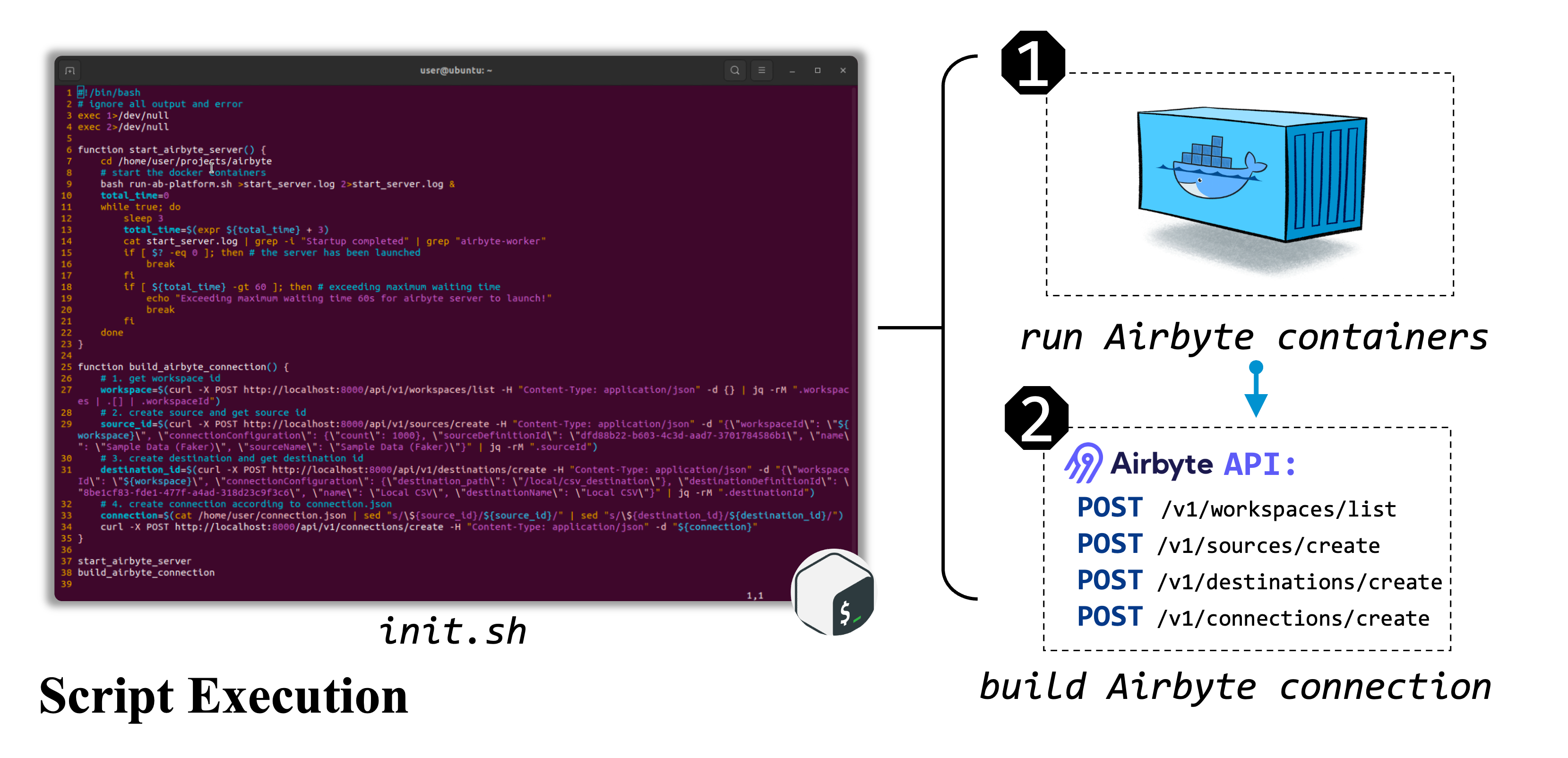Spider2-V: How Far Are Multimodal Agents From Automating Data Science and Engineering Workflows?

Abstract
Spider2-V Framework Infrastructure

Executable Environment

Task Demonstration
Airbyte and uuid 66936a8e-5cbe-4638-a03a-3ae92eb81e6c) below to showcase:
- 1. .json data format;
- 2. two types of task intructions (abstract and verbose);
- 3. environment setup methods;
- 4. video recording and action trajectory to complete the task;
- 5. task-specific evaluation metric.
For a quick glance on more task exmaples, please refer to the [ Task Viewer](explorer.html) page.
Task Instruction
Video Recording
Action Trajectory
## Action 1
index_80 = (417, 288)
pyautogui.click(index_80)
time.sleep(1)
## Action 2
index_83 = (502, 307)
pyautogui.click(index_83)
time.sleep(1)
## Action 3
index_91 = (883, 404)
pyautogui.click(index_91)
time.sleep(1)
## Action 4
index_102 = (1130, 481)
pyautogui.click(index_102)
time.sleep(1)
## Action 5
index_121 = (1130, 782)
pyautogui.click(index_121)
time.sleep(1)
## Action 6
index_98 = (1130, 430)
pyautogui.click(index_98)
time.sleep(1)
## Action 7
index_105 = (1130, 560)
pyautogui.click(index_105)
time.sleep(1)
## Action 8
index_103 = (1050, 481)
# Clear the current cron expression
pyautogui.click(index_103)
pyautogui.hotkey('ctrl', 'a')
pyautogui.press('backspace')
time.sleep(1)
# Enter the new cron expression
pyautogui.typewrite('0 18 * * *')
time.sleep(1)
## Action 9
index_103 = (1050, 481)
# Clear the current cron expression
pyautogui.click(index_103)
pyautogui.hotkey('ctrl', 'a')
pyautogui.press('backspace')
time.sleep(1)
# Enter the new Quartz cron expression
pyautogui.typewrite('0 0 18 * * ?')
time.sleep(1)
## Action 10
index_134 = (1426, 834)
pyautogui.click(index_134)
time.sleep(1)
## Action 11
DONE
Data Statistics and Comparison
“verbose” means a step-by-step guideline on how to complete the task is included in the instruction.

Key statistics of Spider2-V.
Based on task categories and professional applications to showcase the content intuitively.

Distribution of tasks in Spider2-V
**The headers indicate:** the research field (Field), whether an executable environment is provided (Exec. Env.?), whether enterprise service is utilized (Enter. Serv.?), whether GUI actions are supported (GUI Support?) and some other statistics (e.g., number of involved applications or websites, number of execution-based evaluation functions).
| Spider2-V | |
|---|---|
| Field | Data Science &Engineering |
| # Tasks | 494 |
| Exec. Env. ? | ✔️ |
| Enter. Serv.? | ✔️ |
| GUI Support? | ✔️ |
| # Apps/Sites? | 20 |
| # Exec. Eval. Func. | 151 |
| Spider1.0 | DS1000 | Arcade | Intercode | SheetCopilot | MLAgentBench | SWEBench | Mind2Web | WEBLINX | GAIA | WebArena | WorkArena | OSWorld | AitW | AndroidWorld |
|---|---|---|---|---|---|---|---|---|---|---|---|---|---|---|
| Text-to-SQL | Data Science | Data Science | Data Science | Sheet Coding | Machine Learning | Software Engineering | Web | Web | Web | Web | Web | Computer Control | Android | Android |
| 1034 | 1000 | 1082 | 1350 | 221 | 13 | 2294 | 2000 | 2337 | 466 | 812 | 29 | 369 | 30k | 116 |
| ❌ | ❌ | ❌ | ✔️ | ❌ | ✔️ | ❌ | ❌ | ❌ | ❌ | ✔️ | ✔️ | ✔️ | ❌ | ✔️ |
| ❌ | ❌ | ❌ | ❌ | ❌ | ❌ | ❌ | ❌ | ❌ | ❌ | ❌ | ✔️ | ❌ | ❌ | ❌ |
| ❌ | ❌ | ❌ | ❌ | ❌ | ❌ | ❌ | ✔️ | ✔️ | ❌ | ✔️ | ✔️ | ✔️ | ✔️ | ✔️ |
| 1 | 1 | 1 | 3 | 1 | 4 | 12 | 137 | 155 | n/a | 5 | 1 | 9 | 357 | 20 |
| 0 | 0 | 0 | 3 | 0 | 13 | 1 | 0 | 0 | 0 | 5 | 7 | 134 | 0 | 6 |
Benchmarking
| Rank | Model | Details | Score |
|---|---|---|---|
|
1 Jun 3, 2024 |
GPT-4V (1106)
OpenAI OpenAI, '23 |
SoM + EF + RAG t=1.0, top-p=0.9 len = 128k |
14.0 |
|
2 Jun 2, 2024 |
GPT-4o (0513)
OpenAI OpenAI, '24 |
SoM + EF + RAG t=1.0, top-p=0.9 len = 128k |
13.8 |
|
3 Jun 5, 2024 |
Gemini-Pro-1.5
|
SoM + EF + RAG t=1.0, top-p=0.9 len = 128k |
9.1 |
|
4 June 6, 2024 |
Claude-3-Opus
AnthropicAI Anthropic, '24 |
SoM + EF + RAG t=1.0, top-p=0.9 len = 200k |
8.1 |
|
5 June 6, 2024 |
Llama-3-70B
Meta Meta Llama, Meta, '24 |
a11ytree + EF + RAG t=1.0, top-p=0.9 len = 32k |
2.0 |
|
6 June 6, 2024 |
Mixtral-8x7B
MistralAI Jiang et al., '24 |
a11ytree + EF + RAG t=1.0, top-p=0.9 len = 32k |
0.8 |
|
7 June 6, 2024 |
Qwen-Max
Qwen Qwen Team, '24 |
a11ytree + EF + RAG t=1.0, top-p=0.9 len = 32k |
0.6 |
Analysis



Acknowledgement
We thank Yiheng Xu, Hongjin Su, Xiaochuan Li, and Toh Jing Hua for their helpful assistance and feedback on this work.




 In the current task, we adopt the information-based metric to check whether the schedule is correctly altered to
In the current task, we adopt the information-based metric to check whether the schedule is correctly altered to